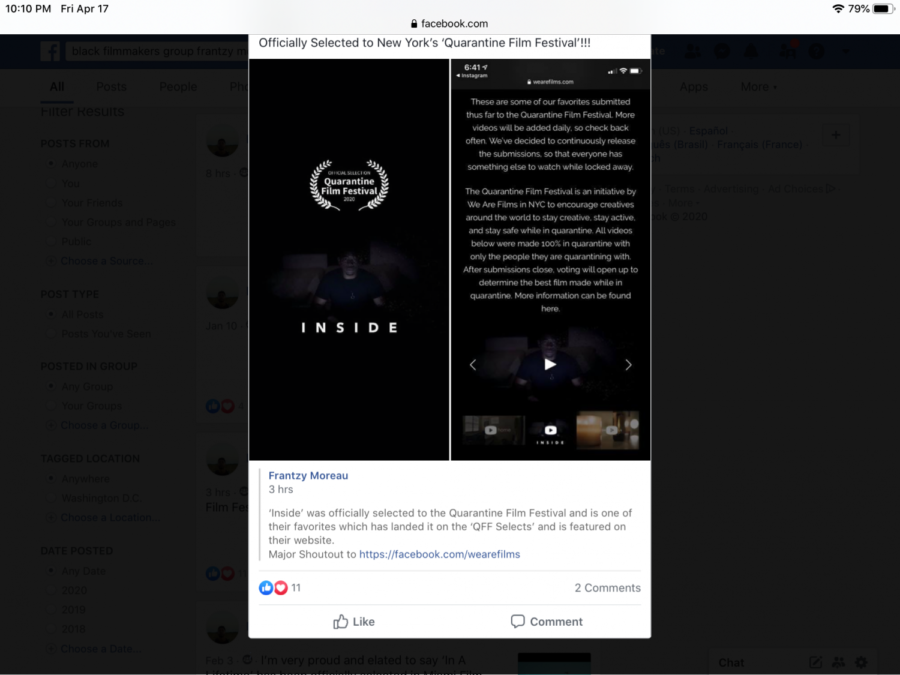
During these scientifically incalculable times of the Coronavirus pandemic aka “Rona” and COVID-19, Americans have been faced with the daunting existence of staring down the (figurative) barrel of their own mortality as they witness the precarious mortality of Americans all around them. Many poor and working class Americans must make the difficult decision to either self-quarantine and risk loosing everything or put their lives at risk and go to work due to a shortage of testing kits. Americans must undergo all of this while watching millionaire celebrities go on social media and brag with talk of how many times they have been treated and retested as they are being provided with adequate treatment. Meanwhile our inadequate mental health system continues to plague the American landscape.
Filmmaker Frantzy Moreau has done a skillful job of taking viewers “Inside” the cognitive rabbit hole of poor and working class Americans (more specifically Afro-Americans and healthcare workers) faced with the everyday reality of this pandemic. In his short film “Inside” written and performed by Moreau, direction and cinematography by Christopher Irarrazabal addresses mental health and suicide by providing viewers with an externalized demonstration of what happens in the human brain when both the (id), the pleasure principle, and the (superego), the morality/rationality portion of the human psyche struggles to find balance. As the (id) played by Moreau and the (superego) played by Moreau grapple with this existence, The (ego) also played by Moreau comically sits back and watches the internalized struggles interplay. All of the preceding personality theories by-the-way defined and discovered by German Psychologist Sigmund Freud in 1923.
I can certainly remember old 1980’s situation comedies and cartoons utilizing the “devil” on one shoulder and “angel” on the other approach, as the main character struggles to reconcile with his/her own moral position. I enjoyed Moreau’s ability to utilize the perfect symmetry of comedy and poignancy on such a sobering topic without syruping it up. This short film was very well executed from the perspective of lighting composition/cinematography, providing viewers’ with the perfect juxtaposition of a clear and crisp, yet dimly-lit depressed background as he takes the viewers on this harrowing yet comical journey.
Unfortunately many professional filmmakers and filmgoers have a tendency to focus more on the moving images while taking for granted the importance of sound quality and music in filmmaking. As a professional musician that has experienced countless rehearsal sound checks and in recording studio sessions, I appreciated the attention Moreau paid to providing his listening viewers with a higher quality noise reduced experience than usually found in films by younger filmmakers. Although I enjoyed the subtle transition from Tchaikovsky’s Nutcracker theme to more somber orchestral low strings, low brass, french horn and a melodic variation of the original celeste Nutcracker theme, I would caution Moreau to be just as knowledgeable about the music that he chooses as he is about all of the other elements of filmmaking. The use of an excerpt from Ballet The Nutcracker Dance of the Sugar Plum Fairy was originally written as a reference to the Christmas holiday which is generally associated with happiness and festivities rather than mortality and uncertainty. This is a minuscule critique of an otherwise very well put together short film.
Although many Americans continue to refer to the virus as a disease, unknowingly confusing the Corona (virus) with COVID-19 (terminal illness) i.e., HIV (virus) AIDS (terminal illness). I certainly appreciated Moreau’s attempt to broach the subject matter of America’s poorly constructed mental and medical healthcare system that leaves average everyday working class Americans physically and emotionally vulnerable to this pandemic. Moreau carefully touches on this topic while simultaneously providing entertainment to an otherwise anxious and frightened nation. Just think, Moreau took the time to create this small work of art while under self quarantine. I think that it is safe to say that this young filmmaker has a very bright future ahead of him tackling the topics of our time. To learn more about Frantzy Moreau films you can visit him on Instagram @frantzymoreau. Also visit The National Suicide Prevention Lifeline at 1-800-273-8255.
Subsequent to this review “Inside” was officially selected for the NYC Quarantine Film Festival. “Inside” was also selected and placed on QFF’s website as one of QFF’s favorites.

Shunda Wallace is a musician, composer/orchestrator, filmmaker, music psychotherapist and author. Visit Shunda on shundawallace.com (on any device) or shundawallace.com (on computer or laptop).